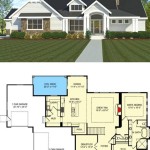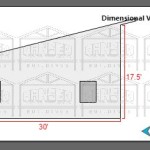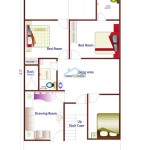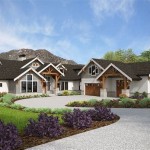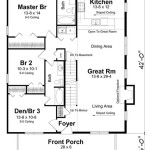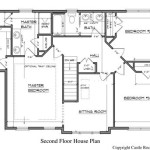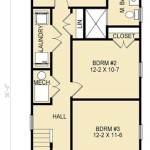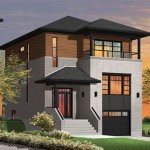Simple Ranch Style Floor Plans: A Comprehensive Overview
Ranch style homes, also known as ramblers, are a popular architectural style characterized by their single-story construction, horizontal layout, and attached garage. They originated in the United States in the 1930s and gained significant popularity in the post-World War II era, becoming a staple of suburban landscapes. Simple ranch style floor plans prioritize ease of living, functionality, and efficient use of space, making them an attractive option for various demographics, from young families to retirees.
These homes are typically built on a slab foundation, although crawl spaces and basements are also possible. The defining characteristic remains the absence of stairs, fostering accessibility and convenience. The floor plans often feature an open concept layout, combining the living room, dining area, and kitchen into a single, unified space. This design promotes social interaction and allows for a seamless flow between different areas of the home.
The exterior of a ranch style home often includes a low-pitched roof, large windows, and a simple facade. The emphasis is on understated elegance and practicality. The materials used in construction can vary, ranging from brick and wood siding to stucco and stone accents. The design's adaptability allows for customization to suit individual preferences and regional architectural styles.
Key Features of Simple Ranch Style Floor Plans
Several defining features contribute to the appeal and functionality of simple ranch style floor plans. Understanding these elements is crucial for discerning their advantages and suitability for specific needs.
Single-Story Living and Accessibility
The single-story design is arguably the most prominent feature of ranch style homes. This eliminates the need for stairs, making the home accessible to individuals with mobility limitations, such as elderly residents or those with disabilities. Furthermore, single-story living simplifies household tasks like cleaning and laundry, as everything is conveniently located on one level. The absence of stairs also reduces the risk of falls, contributing to a safer living environment, particularly for young children and seniors.
Accessibility extends beyond physical mobility. The open-plan layout typical of ranch homes facilitates easy movement between rooms. This is particularly beneficial for individuals who use wheelchairs or walkers. Wide doorways and hallways can be incorporated into the design to further enhance accessibility. Ranch homes can be easily adapted to accommodate universal design principles, ensuring they remain functional and comfortable for residents throughout their lives.
From a maintenance perspective, single-story living simplifies exterior upkeep. Tasks such as roof repairs, gutter cleaning, and window washing are generally easier to manage compared to multi-story homes. This can translate to lower maintenance costs and reduced physical strain for homeowners.
Open Concept Layout and Functionality
The open concept design is another hallmark of simple ranch style floor plans. This layout typically combines the living room, dining area, and kitchen into a single, interconnected space. The absence of walls between these areas promotes a sense of spaciousness and encourages social interaction. This design is particularly well-suited for families who enjoy spending time together and entertaining guests.
The open concept layout also enhances natural light penetration throughout the home. With fewer walls obstructing the flow of light, the interior feels brighter and more inviting. This can lead to reduced reliance on artificial lighting, potentially lowering energy consumption. Large windows and sliding glass doors are often incorporated into the design to further maximize natural light.
While the open concept is beneficial for social interaction, it's important to consider the potential for noise transmission. Careful planning and the use of sound-dampening materials can help mitigate this issue. Strategically placed area rugs, upholstered furniture, and soundproof insulation can reduce echo and minimize noise levels. Zoning within the open space, using furniture arrangement and subtle architectural features, can help define distinct areas and provide a sense of separation when needed.
Functionality is also enhanced by the open layout. The seamless flow between the kitchen, dining area, and living room makes meal preparation and serving easier. Parents can supervise children while cooking or relaxing in the living room. The open space can also be easily adapted to accommodate various activities, from family game nights to holiday gatherings.
Attached Garage and Convenient Access
The attached garage is a common feature of ranch style homes, providing convenient access to the home and protection for vehicles from the elements. This feature is particularly valuable in regions with harsh weather conditions, such as heavy snow or extreme heat. The attached garage eliminates the need to walk outside in inclement weather, making it easier to load and unload groceries, transport children, and access the car.
Beyond vehicle storage, the attached garage can also serve as a workspace or storage area. Many homeowners utilize the garage for hobbies, DIY projects, or storing outdoor equipment. Proper insulation and ventilation can make the garage a more comfortable and functional space. The garage can also be connected to the home's electrical and plumbing systems, allowing for the installation of appliances such as a washing machine, dryer, or refrigerator.
The placement of the attached garage is typically integrated into the overall design of the ranch home. It is often located on one side of the house, providing direct access to the kitchen or mudroom. This proximity streamlines tasks such as bringing groceries into the house and transitioning between indoor and outdoor activities. The garage can also serve as an extension of the living space, particularly during warm weather months. Opening the garage door can create a larger, more open area for entertaining or relaxing.
Popular Variations in Simple Ranch Style Floor Plans
While the basic characteristics of ranch style homes remain consistent, various floor plan variations cater to different needs and preferences. These variations often involve modifications to the layout, size, and features of the home.
L-Shaped Ranch Homes
L-shaped ranch homes are characterized by their distinct L-shaped layout. This design typically features a main living area and a bedroom wing that extends perpendicularly. The L-shape creates a natural separation between living spaces and sleeping areas, providing greater privacy for bedrooms. The configuration also allows for a larger backyard space, as the house wraps around the perimeter of the property.
The L-shape can also create a more interesting and dynamic exterior appearance. The two distinct wings of the house can be finished in different materials, adding visual interest and architectural detail. The angle formed by the L-shape can also be utilized to create a sheltered outdoor patio or courtyard area.
The L-shaped layout can be particularly well-suited for homes with a view. The main living area can be oriented to maximize the view, while the bedroom wing can be positioned to provide privacy and protection from the elements. The L-shape can also be adapted to accommodate sloping lots, allowing for a more seamless integration with the surrounding landscape.
U-Shaped Ranch Homes
U-shaped ranch homes feature a layout where the house wraps around a central courtyard or patio. This design creates a private and sheltered outdoor space that can be used for entertaining, relaxing, or gardening. The U-shape also allows for natural light to penetrate the interior from multiple directions, creating a brighter and more airy living environment.
The courtyard area in a U-shaped ranch home can be customized to suit individual preferences. It can be landscaped with gardens, paved with stone or concrete, or even include a swimming pool or spa. The courtyard can also be accessed from multiple rooms in the house, creating a seamless connection between indoor and outdoor living spaces.
U-shaped ranch homes are often found in warmer climates where outdoor living is prevalent. The courtyard provides a protected and private space to enjoy the outdoors year-round. The U-shape can also help to buffer the house from wind and noise, creating a more peaceful and comfortable living environment.
Split-Level Ranch Homes
Split-level ranch homes are a variation that incorporates multiple levels connected by short flights of stairs. This design typically features a main living level, a bedroom level, and a lower level that may be used for a family room, recreation area, or garage. Split-level ranch homes are often built on sloping lots, where the different levels can be terraced into the hillside.
The split-level design allows for a more efficient use of space compared to a traditional single-story ranch home. The multiple levels provide distinct areas for living, sleeping, and recreation, while still maintaining a relatively compact footprint. The split-level layout can also create a greater sense of privacy between different areas of the house.
Split-level ranch homes can be a good option for families with teenagers or young adults who desire more independence. The lower level can be used as a separate living space for these individuals, providing a degree of privacy and separation from the main living areas. The split-level design can also be adapted to accommodate a home office or guest suite.
Factors to Consider When Choosing a Simple Ranch Style Floor Plan
Selecting the appropriate ranch style floor plan involves careful evaluation of individual needs, preferences, and site conditions. Various factors influence the suitability of a particular plan.
Family Size and Lifestyle
The size of the family and their lifestyle are primary considerations when choosing a ranch style floor plan. A larger family will require a home with more bedrooms and bathrooms. The floor plan should also accommodate the family's lifestyle. For example, a family that enjoys entertaining might prioritize an open concept layout with a large kitchen and dining area. A family with young children might prefer a home with a fenced backyard and a playroom or family room.
The age and needs of family members should also be considered. A family with elderly residents might prioritize a single-story home with accessible features, such as wide doorways and grab bars in the bathrooms. A family with teenagers might prefer a split-level home that provides greater privacy for different age groups.
The long-term needs of the family should also be taken into account. A home that is suitable for a young family might not be adequate as the children grow older. Consider the potential for future expansion or renovation when choosing a ranch style floor plan.
Lot Size and Shape
The size and shape of the building lot will also influence the choice of a ranch style floor plan. A narrow lot might not be suitable for a wide, sprawling ranch home. A sloping lot might require a split-level or raised ranch design. The orientation of the lot can also impact the placement of the house and the design of the floor plan. For example, a south-facing lot might be ideal for a home with large windows that capture sunlight during the winter months.
Zoning regulations and building codes can also impact the design of a ranch style home. Setback requirements, height restrictions, and other regulations can limit the size and placement of the house on the lot. It is important to consult with local authorities before selecting a floor plan to ensure that it complies with all applicable regulations.
The surrounding landscape should also be considered when choosing a ranch style floor plan. A home that blends seamlessly with the natural environment will be more aesthetically pleasing and enjoyable to live in. Consider the views from the house and the potential for outdoor living spaces when selecting a floor plan.
Budget and Construction Costs
The budget and construction costs are critical factors in the selection of a ranch style floor plan. The cost of building a home can vary significantly depending on the size, design, materials, and location. A larger home with more complex features will generally be more expensive to build than a smaller, simpler home.
Consider the cost of materials, labor, and permits when estimating the construction costs. Obtain multiple bids from contractors to ensure that you are getting a fair price. Be prepared to make compromises on certain features or materials in order to stay within your budget.
The long-term costs of owning a home should also be considered. Energy efficiency, maintenance requirements, and property taxes can all impact the total cost of homeownership. Choose a ranch style floor plan that is energy efficient and easy to maintain in order to minimize these costs.

Simple Ranch House Plans Houseplans Blog Com

Simple House Plans Google Search Ranch Style Floor

Trending Ranch Style House Plans With Open Floor Blog Eplans Com

10 Gorgeous Ranch House Plans Ideas

Trending Ranch Style House Plans With Open Floor Blog Eplans Com

Beautifully Simple Ranch House Plans Dfd Blog

Ranch Style House Plan 3 Beds 2 Baths 1494 Sq Ft 1010 23 One Floor Plans New

Ranch Style House Plans Fantastic Small Floor

Simple Ranch House Plans Houseplans Blog Com

Plan 40686 Small Ranch House With Two Master Closets 1400

